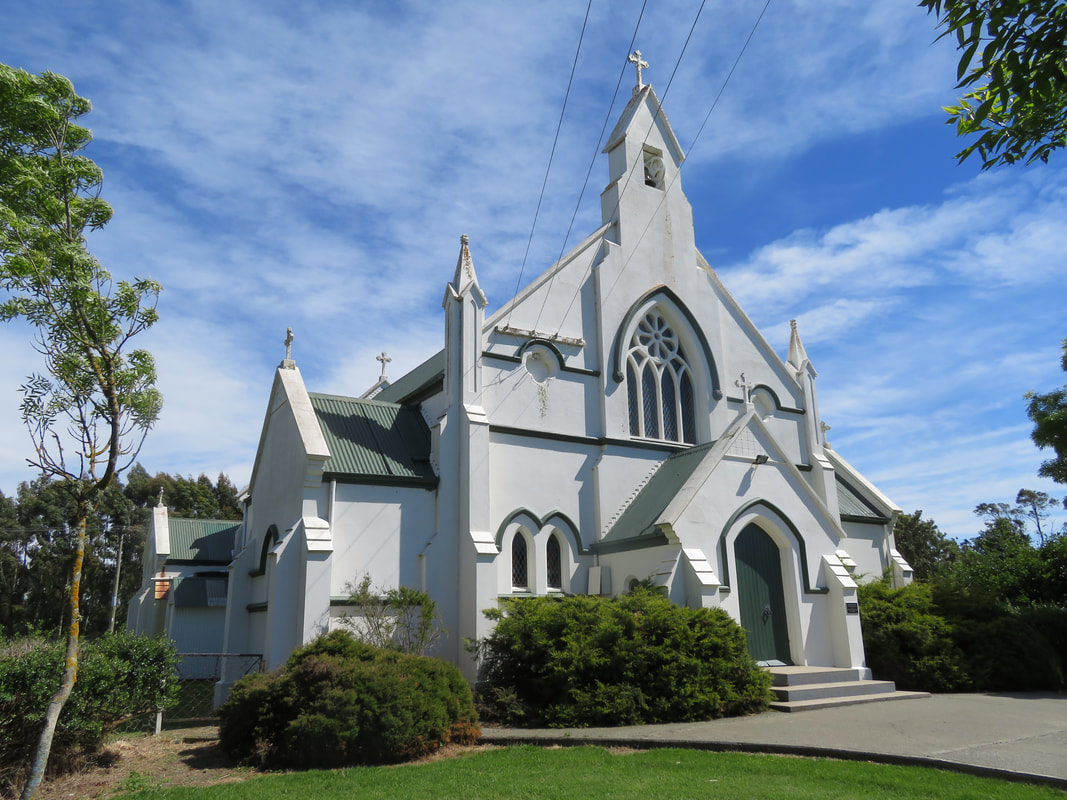|
If you glance up Eliot St as you drive south through the township of St Andrews, you get a great view of the Eastern end of a most handsome little church. Smartly painted in white with green trim, this is St Andrews, the local Catholic church. Land for this church was originally purchased in 1895 by Father Hurlin and an enthusiastic parishioner for the princely sum of 8 pounds an acre. They purchased a total of 9 acres with the view towards future plans including perhaps a school, presbytery and convent. The need for these never arose and the unneeded land was sold off over the years. Sadly neither of these two farsighted individuals lived to see the foundation stone being laid just a few years later in December 1902. This attractive little church was completed in 1903, mainly with volunteer labour, at a cost of 1500 pounds. When the building was finished there was only 100 pounds still owing which speaks volumes about the generosity of the parishioners. This included a little building next to the church which was to provide shelter for the priest’s horse. The architect for the building was Mr J.S. Turnbull and it was built by Mr E. Hall with the timber work being done by Mr P. Foster. The church is constructed of bricks from Quinn’s brickworks at Makikihi, these sit atop concrete foundations and are stiffened by buttresses. The exterior walls were cemented and then painted white. The interior timbers are of red pine. The sanctuary is at the Western end and off this, on the north side, is a sacristy with an outer door. The window at the Eastern front which you see from the Main road is ornamented by an arched tracery window and on either side of this is a sunken circular panel to relieve the otherwise blank spaces. The turret rises above this window and houses a brass bell, this turret is topped off by a pretty decorative cross. By all accounts the opening was a festive occasion with bunting flying from the tall scaffolding, flags hung from the awnings. Speeches were held, the choir of the Church of the Sacred Heart in Timaru sang and the Battalion band played to the large crowd in attendance, there were lots of family parties and the neighbourhood was filled with vehicles and horses. The ceremony had to be delayed from 3pm to 3.30 as the Presbyterian church across the road were holding their service and did not wish to be disturbed by the band.
0 Comments
The delicate lacework provided by the scaffolding around St Mary's Church feels quite appropriate in a number of ways.
First, the texture relates to the refined tracery of the historic Gothic cathedrals of Europe, where stone was honed down to very fine dimensions. Such determined commitment to one building over many decades was all aimed at providing depth of detail – shadow and light – to the exterior. In turn the interior treatment was aimed at achieving a subtlety and presence seemingly beyond mere mortals. A second sense of satisfaction in seeing the scaffolding erected this week has been the evident commitment by the church authorities to restore the exterior. Climbing to the topmost platforms shown here to repair the finials on the gable ends, will surely convey a sense of pride to those special tradesmen involved. An architectural term for today: fleche – the narrow spire located on the ridge line. St Mary's stands as an important element in the CBD – since the demolition of the Hydro Grand Hotel it is now the most photographed building in town. With the renovation of the interior of Chalmers Church, and the fairly recent restoration of the Roman Catholic basilica, 3 landmark buildings have each been given a new life - to the benefit of the wider community and to visitors. David McBride |
View by date Archives
February 2021
Categories |
|
|




